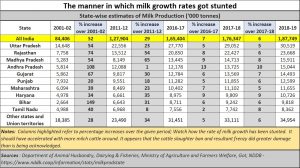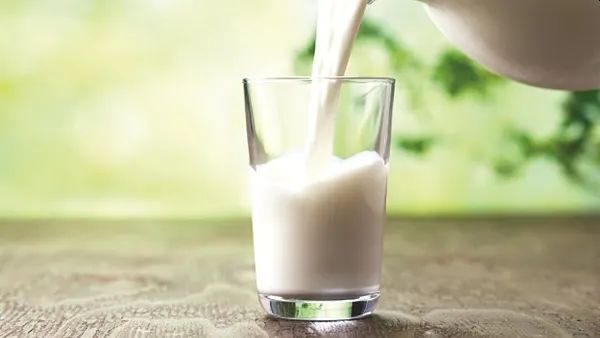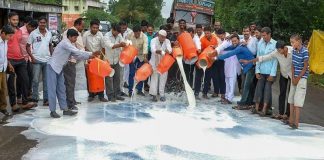https://www.freepressjournal.in/analysis/verghese-kuriens-milk-model-curdled
How the government has curdled the Verghese Kurien’s milk model
RN Bhaskar — 20 February, 2020
If you can read the tea leaves – you can predict that the government will decimate the Kurien model for milk production, nutrition and growth in India. Watch the growth rates for the milk industry getting stunted (see chart)
Kurien wanted a vibrant milk industry capable of growth:
- without government subsidies,
- without the need for imports which could play havoc with market prices
- without subjecting farmers to the vagaries of market pricing by using NDDB as a market stabilizer and market maker.
 But this dream is being smothered. Unless the farmers put up a fierce fight immediately; or saner counsels in the government put an end to this nightmare.
But this dream is being smothered. Unless the farmers put up a fierce fight immediately; or saner counsels in the government put an end to this nightmare.
Thanks to Kurien, India became the world’s largest milk producer, He did so by ensuring larger payments to farmers – Gujarat’s cooperatives pay 80% of the market price to farmers. He compressed processing marketing, procurement, distribution within the 20%. That left no money for politicians, who were sore. Kurien did not care for them, and they have now decided to wreak revenge by destroying his industry.
Consequently, expect farmers
- to lose out on milk pricing within the next five years;
- to be subject to doles, where their loyalties begin to be wooed by the processing centre which pays him more, and thus bankrupt the one which who was reliable and apolitical;
- to discover that India’s milk industry begins to lose clout, because the government favours import under one guise or another. Imports will break this industry. Not canalizing imports through NDDB the way Kurien did will allow the government to play favourites (for a better understanding of the milk industry refer to the author’s Game India, Seven Strategic ways to steer India to strength — Penguin);
- to discover that milk is no longer the shortest route to rural prosperity – each farmer can make profits of around Rs.100 per cattle per day, for 300 days a year. Instead, the government will usher in farm distress in much the same way it did with oilseeds, pulses and other crops (except rice and wheat).
To understand how the game is being played out, just consider the following moves of the government
- It announced a cattle slaughter ban, and also persecuted traders who were transporting only buffalo-meat. As a result, farmers could not sell their old buffalo as well, hence could not purchase a fresh cattle head with the money they got from the sale of the old animal. Result: milk production declined. The leather industry also suffered; so did the carabeef industry. Jobs were lost, and farmers were rendered poorer.
- A renegade member of one of the largest milk cooperative movement in India decided to boost his milk processing capacity without consulting other members of the federation (never mind the fact that he was also well connected politically). He then demands higher voting rights in the federation, a proposal which is shot down. He then procures milk from non-cooperartives, a move not permitted by the federation. Renegades like him claim losses, hence want to export. They then export skimmed milk powder (SMP) with government subsidies. The era of subsidies in the milk industry begins. Kurien was staunchly against subsidies as they eventually hurt farmers and gave politicians more power over farmers’ fortunes. And subsidies weaken India’s case before the WTO [World Trade Organisation].
- A move is made to break the milk industry by allowing New Zealand to export milk products to India. This is resisted fiercely by farmers. India backs out of the RCEP. Recent reports suggest that the government will now allow USA to export its milk products to India. Expect more protests.
- Meanwhile, the government subsidises export of SMP by favoured Indian players, when it should have been used as buffer stock (http://www.asiaconverge.com/2020/02/government-destroying-indias-milk-industry/). Cattle slaughter bans stunt milk production growth. Just last week, traders demanded import of SMP.
- Over the past few years the state governments of Maharashtra and Karnataka have started giving subsidies to politically connected milk producers. Thus all taxpayers are further penalised. Karnataka’s milk producers get Rs.6 per litre as milk subsidy to heop them pay farmers Rs.26 per litre. Maharashtra pays milk producers Rs.5 to pay farmers Rs.25 per litre. Cost control is forgotten. Inefficiency is rewarded. Everyone forgets how Gujarat can pay farmers Rs.34 per litre without subsidies. Hatsun, India’s largest private milk producer, pays farmers Rs.26 per litre, without subsidies. Is this collusion among politicians?
Quite obviously, the process of demolishing Kurien’s dream has just begun. Make-in-India becomes irrelevant. What matters is politician connect.
So, watch the most successful agricultural strategy in India get pulverized to death. Start singing your dirges for the Kurien model.





































COMMENTS